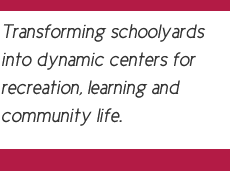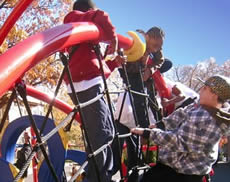News
| Contact Information |
| Study: Boston teachers effectively engaging students in outdoor science learning |
| (December 16, 2013) -
New research points to the educational benefits of the BOSTON – A new independent study reports that nearly 70% of participating Boston Public Schools (BPS) teachers are using transformed schoolyards and outdoor classrooms to engage elementary school students in science education, and that BPS students with outdoor science lessons expressed increased interest in science, an important indicator of future success in science. The Boston Schoolyard Initiative commissioned the external study to evaluate the impact of Science in the Schoolyard (SSY), a professional development program to help teachers use the urban natural environment in their schoolyard to teach science lessons aligned to the district curriculum. Outlier Research and Evaluation (formerly the Center for Elementary Math and Science Education) at The University of Chicago conducted the study, which included interviews with teachers and principals, focus groups, observations, and a survey of 100 elementary science teachers from 55 Boston Public Schools. About 60% of the teachers surveyed had participated in at least one Science in the Schoolyard course. The research also included a survey of nearly 800 students in grades 3-5 at seven elementary schools, as well as student focus groups. Findings showed that student participation in outdoor science lessons is associated with more positive science attitudes, behaviors, and activities. The report states, “Many teachers reported that when their students are able to touch, feel and interact with phenomena outside, they are not only more interested, but the learning is more authentic and meaningful to them.” National research indicates that students’ level of interest in science during elementary school is a strong predictor of completing advanced study in science later in their educational career. Among the findings of the study: “Teachers in the Boston Public Schools have demonstrated the value and power of bringing students outdoors to learn about science and nature,” said Myrna Johnson, Executive Director of the Boston Schoolyard Initiative. “This report affirms that educators and students alike have more meaningful, hands-on experiences in teaching and learning through outdoor science instruction. The work in Boston sends a message to other school districts that science teachers can effectively conduct outdoor science lessons, with positive impacts for both students and teachers.” The Boston Schoolyard Initiative (BSI) began in 1995, when Mayor Thomas M. Menino convened a broad-based Schoolyard Task Force to devise a process for funding projects and using them for recreational and educational purposes. Eighteen years later, after a public-private investment of more than $20 million in 88 schoolyards, two of the founding players of the initiative – the Boston Schoolyard Funders Collaborative and Mayor Menino himself – will conclude their involvement at the end of this year. Through BSI’s Science in the Schoolyard program, Boston Public Schools has emerged as a national leader in developing resources, infrastructure and professional development for taking science learning outdoors. The BSI Science in the Schoolyard model of fully integrating outdoor lessons into science teaching throughout the district is unique nationally, representing the largest implementation of outdoor science teaching in a public school system in the country. Because of the BSI-BPS partnership, resources available to Boston schools include: 32 outdoor classrooms on BPS schoolyards; guides to taking the BPS science curriculum units (STC® and FOSS®) outdoors; 12 teacher leaders who are trained to deliver SSY courses; and 200 teachers who have participated in SSY professional development courses. Officials noted that by the end of this month, the Boston Schoolyard Initiative will have achieved its goal of transforming every feasible elementary and K-8 schoolyard in the Boston Public Schools, an accomplishment few other cities can boast. John McDonough, Interim Superintendent of the Boston Public Schools, said the district is committed to continuing support for outdoor education and recreation, including maintenance of schoolyards and professional development opportunities for teachers. “We are proud that Boston’s schoolyards have emerged as extensions of the school learning environment,” said Mr. McDonough. “Our teachers have embraced the innovative training and resources that enable them to bring the curriculum outdoors in ways that are meaningful to urban students.” To download the complete report, visit http://cemse.uchicago.edu/BSI-SSY/. Boston Schoolyard Initiative by the numbers: • 88 schoolyards renovated (every feasible elementary and K-8 school in the city) # # # |




